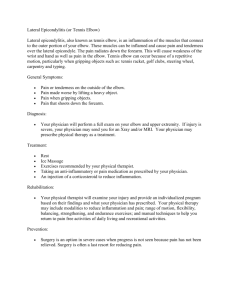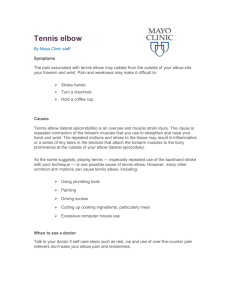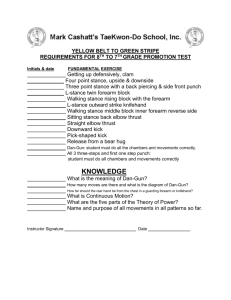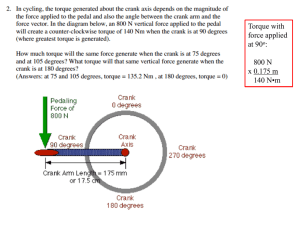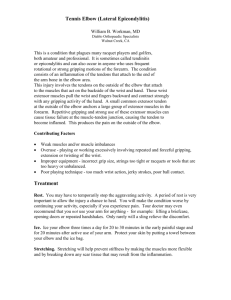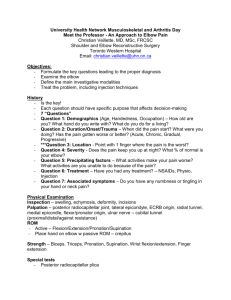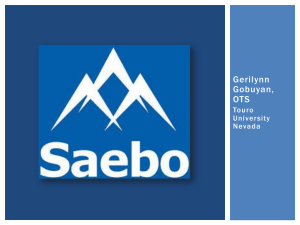Arm/Elbow
advertisement
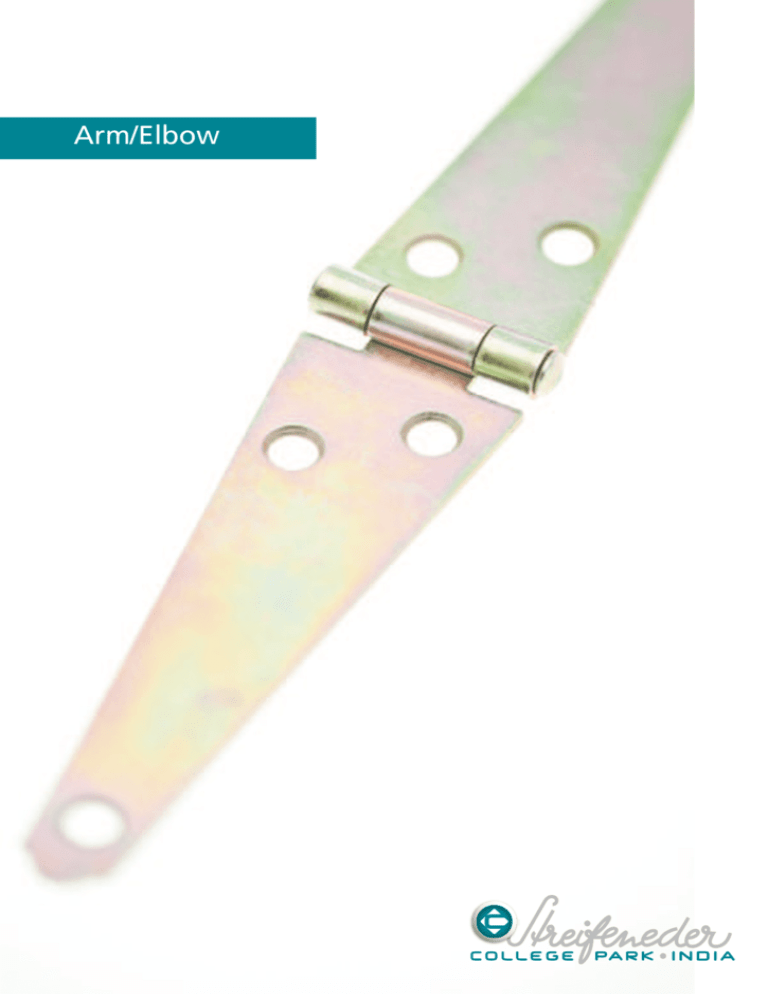
Arm/Elbow Arm/Elbow The arm resp. the free upper extremity is divided into upper arm (brachium), forearm (antebrachium) and hand (manus). The arm is the human body part with the greatest mobility of all, which is based on the construction of the shoulder joint. The upper arm bone (humerus) is the longest bone of the arm. Its rounded head (caput humeri) is located proximally and is part of the shoulder joint. Distally at the upper arm bone, two large upper arm condyles (epicondylus medialis et lateralis) are adjoined which are positioned laterally of the elbow joint. The upper arm muscles can be divided into the bending (flexors) and extending (extensors) muscles. The most important upper arm muscles are positioned in the front, in order to bend the forearm (musculus biceps brachii et musculus brachialis). The muscles to extend the forearm (musculus triceps brachii) are located at the backside of the upper arm. The forearm merges between elbow joint (articulatio cubiti) and wrist (carpus) and consists of two bones: the spoke bone (radius) and the ulna bone (ulna). The forearm muscles can be also divided into two groups the bending (flexors) and extending (extensors) muscles. The muscles mostly merging from the forearm move the hand as effector. The “ell“ is one of the oldest nature measures. It measures the distance between elbow and second fingertip. Especially tailors used this measure. Why or when the second “l“ was dropped from the word, is unknown The elbow (cubitus) connects upper- and forearm, During bending and extending the elbow, a hinge- consists of crook of the arm (fossa cubitalis) and the like movement occurs between upper- and forearm. elbow joint (articulatio cubiti). Due to the merging Because of the three-part construction (rotating and of upper arm bone, spoke bone and ulna bone, the hinged joint) of the elbow joint, rotating movements elbow joint consists of three partial joints (articulatio of the forearm in the sense of supination and humeroradialis, articulatio humeroulnaris, articulatio pronation are also possible, during which the spoke radioulnaris proximalis), which are surrounded by a bone rotates around the ulna bone. Several large common joint capsule. This capsule is reinforced by nerve cords run parallel along the upper arm bone and three ligaments: inner ligament, outer ligament and innervate the flexors (mainly nervus medianus) and ring ligament. extensors (mainly nervus radialis) of the forearm. Arm/Elbow – Epicondylitis Therapy This pain syndrome is a classic overload symptom caused by overstraining the forearm muscles by monotone, constantly repeating movements, incorrect postures or everyday techniques; as well as incorrect sleeping posture in lateral position. The orthopaedist differentiates between “tennis arm“ (epicondylitis humeri radialis) and “golf elbow“ (epicondylitis humeri ulnaris). The more common “tennis arm“ is usually an irritation of the extension muscle insertion of the forearm, while the less common “golf elbow“ concerns the insertion of the flexing forearm muscle. The corresponding condyle is sensitive to pressure and physical contact. Every mechanical strain against the extending or flexing musculature is painful. Several methods are available to treat an epicondylitis; besides medication with ointments or gels containing diclofenac, there are also physio-therapeutical approaches to heal this overload emergence. The painful section can be e. g. cooled with ice, treated with massage to loosen the musculature or therapied with electric stimulation by means of a TENS-unit. Orthopaedic aids such as an arm sling provide absolute immobilisation on the one hand or, on the other, are supporting a functional therapy with braces or supports. Surgery is only necessary in very rare cases. Prophylaxe Man is a creature of habit. This truism can also be transferred to learned or trained behaviour- and motion patterns. Especially in our information society, computer work has become essential; which can be very stressful and straining for our hands operating the keyboard and the mouse. Once a painful overstrain has been developed, one will be forced to reconsider his habits. An approach to solve this would be e. g. an ergonomical shaped keyboard or a new hand rest for the mouse, to protect oneself from overstraining. Arm/Elbow D-E-S-A Epicondylitis Support to discharge muscle cords Mode of Action ■■ for right and lefthanders, according to Dr. med. Werner Zirngibl ■■ tension relief for the entheses at the epicondylus ■■ the compressing effect to the forearm muscle eases the discomfort during physical strain ■■ comfortable to wear due to silicone cover, especially suitable for allergic persons Indication ■■ entheses and insertion tendinopathy at Epicondylus radialis and ulnaris, caused by physical strain Contraindication ■■ material interactions/allergies ■■ do not wear directly on injured, irritated or damaged skin ■■ circulatory disorders ■■ paralysis (e. g. hemiparesis) 5 www.streifeneder-collegepark.in ■ Size Forearm circumference Side Item-No. 1 240 - 260 mm left 139T4/1L 2 270 - 290 mm left 139T4/2L 3 300 - 320 mm left 139T4/3L 4 330 - 350 mm left 139T4/4L 1 240 - 260 mm right 139T4/1R 2 270 - 290 mm right 139T4/2R 3 300 - 320 mm right 139T4/3R 4 330 - 350 mm right 139T4/4R Phone +91 124 2579825 ■ Fax +91 124 2579826 Arm/Elbow EpiMax.light Elbow Brace without silicone pads Mode of Action ■■ supports and protects ligaments, capsules, joint and cartilage ■■ relieves the joint and therefore helps to avoid wrong movements ■■ due to the special knitting technique and the integrated silicone pads, the EpiMax.light elbow brace provides compression of the soft parts in the elbow area ■■ improves blood circulation and lymph drainage, which reduces swelling, eases the pain and helps to improve joint function Indication ■■ epicondylopathies (e. g. tennis-, golfer´s elbow) ■■ osteoarthritis/arthritis ■■ postoperative and postraumatic irritation ■■ tendomyopathy Contraindication ■■ material interactions/allergies ■■ do not wear directly on injured, irritated or damaged skin ■■ circulatory or sensory disorders of the hand ■■ paralysis (e. g. hemiparesis) ■■ remove the brace during longer periods of rest (e. g. while sleeping etc.), as the therapeutic effect of the EpiMax.light elbow brace is mostly provided during physical activity 41B1 - silver/anthracite Size Forearm circumference Colour Item-No. XS 19 - 21 cm silver/anthracite 41B1/XS S 21 - 23 cm silver/anthracite 41B1/S M 23 - 25 cm silver/anthracite 41B1/M L 25 - 27 cm silver/anthracite 41B1/L XL 27 - 29 cm silver/anthracite 41B1/XL XXL 29 - 31 cm silver/anthracite 41B1/XXL Size Forearm circumference Colour Item-No. XS 19 - 21 cm flesh 40B1/XS S 21 - 23 cm flesh 40B1/S M 23 - 25 cm flesh 40B1/M L 25 - 27 cm flesh 40B1/L XL 27 - 29 cm flesh 40B1/XL XXL 29 - 31 cm flesh 40B1/XXL 40B1 - flesh The EpiMax.light can be worn on the left or right side. 6 www.streifeneder-collegepark.in ■ Phone +91 124 2579825 ■ Fax +91 124 2579826 Arm/Elbow EpiMax Elbow Compression Brace with silicone pads Mode of Action ■■ supports and protects ligaments, capsules, joint and cartilage ■■ relieves the joint and therefore helps to avoid wrong movements ■■ due to the special knitting technique and the integrated silicone pads, the EpiMax elbow brace provides compression of the soft parts in the elbow area ■■ improves blood circulation and lymph drainage, which reduces swelling, eases the pain and helps to improve joint function Indication ■■ epicondylopathies (e. g. tennis-, golfer´s elbow) ■■ osteoarthritis/arthritis ■■ postoperative and postraumatic irritation ■■ tendomyopathy Contraindication ■■ material interactions/allergies ■■ do not wear directly on injured, irritated or damaged skin ■■ circulatory or sensory disorders of the hand ■■ paralysis (e. g. hemiparesis) ■■ remove the brace during longer periods of rest (e. g. while sleeping etc.), as the therapeutic effect of the EpiMax elbow support is mostly provided during physical activity 34B1 - silver/anthracite Size Forearm circumference Colour Item-No. XXS 17 - 19 cm silver/anthracite 34B1/XXS XS 19 - 21 cm silver/anthracite 34B1/XS S 21 - 23 cm silver/anthracite 34B1/S M 23 - 25 cm silver/anthracite 34B1/M L 25 - 27 cm silver/anthracite 34B1/L XL 27 - 29 cm silver/anthracite 34B1/XL XXL 29 - 31 cm silver/anthracite 34B1/XXL Size Forearm circumference Colour Item-No. XXS 17 - 19 cm flesh 33B1/XXS XS 19 - 21 cm flesh 33B1/XS S 21 - 23 cm flesh 33B1/S M 23 - 25 cm flesh 33B1/M L 25 - 27 cm flesh 33B1/L XL 27 - 29 cm flesh 33B1/XL XXL 29 - 31 cm flesh 33B1/XXL 33B1 - flesh The EpiMax can be worn on the left or right side. 7 www.streifeneder-collegepark.in ■ Phone +91 124 2579825 ■ Fax +91 124 2579826
